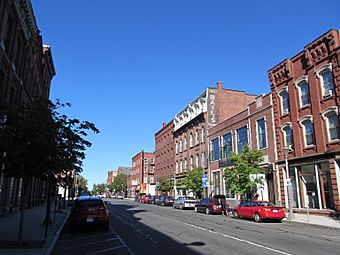North High Street Historic District (Holyoke, Massachusetts) facts for kids
|
North High Street Historic District
|
|

North High Street
|
|
| Location | High St. between Dwight and Lyman Sts.; also 233-411 High St.; also 580 Dwight St. and 230, 234, and 236 Maple St., Holyoke, Massachusetts |
|---|---|
| Area | 6 acres (2.4 ha) (original size) 9.8 acres (4.0 ha) (1992 increase) less than one acre (2008 increase) |
| Built | 1853 |
| Architectural style | Late 19th And 20th Century Revivals, Italianate |
| NRHP reference No. | 86001376 (original) 92001725 (increase 1) 08000897 (increase 2) |
Quick facts for kids Significant dates |
|
| Added to NRHP | June 26, 1986 |
| Boundary increases | December 24, 1992 September 12, 2008 |
The North High Street Historic District is a special area in Holyoke, Massachusetts. It's like a time capsule showing how the city grew. This district is filled with old buildings that tell stories about Holyoke's past. It was first recognized as a historic place in 1986.
When it was first listed, the district covered North High Street between Dwight and Lyman Streets. These buildings were mostly built between 1850 and 1885. They show off popular styles from that time, like Italianate and Second Empire designs.
Over the years, the district has grown. In 1992, it expanded to include more blocks of High Street. This part shows Holyoke's growth during its busiest commercial period, from 1880 to 1930. It even includes the famous Holyoke City Hall. The district grew again in 2008, adding buildings that now house the Holyoke Health Center.
Contents
Holyoke's Early Days and Growth
Before 1847, the area where Holyoke now stands was mostly farmland. It was a quiet agricultural part of West Springfield, Massachusetts. But things changed quickly.
How Holyoke Became an Industrial City
In 1847, a group of investors from Boston bought land along the Connecticut River. They planned to build large factories there. This decision kickstarted Holyoke's transformation into a major industrial city.
The Rise of Paper Production
By 1880, Holyoke was famous for making paper products. It became one of the nation's top producers. The city's population also grew very fast, reaching over 10,000 people. Many of the buildings on High Street were built during this exciting time of rapid growth.
Developing High Street's Commercial Hub
The first part of High Street was fully built by 1880. After that, development spread to the northeast. This growth was helped by the building of Holyoke City Hall in the 1870s. The extension of streetcar lines by the Holyoke Street Railway also encouraged more businesses and homes to be built.



